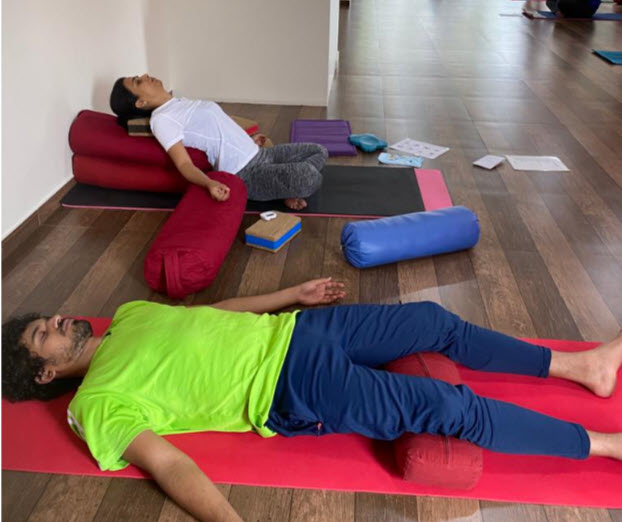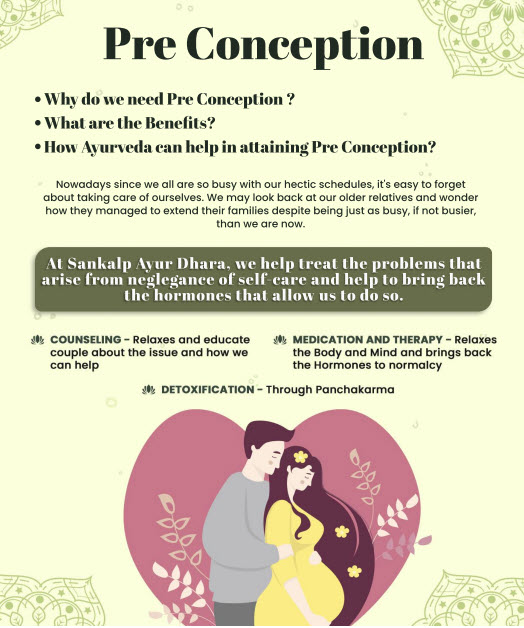PRECONCEPTION YOGA
Preconception yoga exercises benefit reproductive functions, in both men and women by improving their overall physiological systems.
Preconception Yoga Program
When trying to conceive a child, certain factors need to be taken well under consideration. Multiple elements play a huge role during a pregnancy such as maintaining a healthy weight, healthy mindset, your surrounding environment, etc. Hence, when you take such components into consideration, you can conquer all these various issues with the help of Yoga.
Women who want to get pregnant can practise preconception yoga at Sankalp Yoga. Their fertility yoga courses assist you in getting pregnant easily and organically. Sessions are a perfect approach for women to explore the mind-body relationship in fertility.
Yoga has been an ancient practice which has become a popular way to promote not just spiritual but physical and mental well-being as well.
Research shows that a little yoga may help reduce stress, regulate body function and support sperm production, all of which can boost your fertility and help you prepare for a future pregnancy.
These yoga therapies/ preconception yoga exercises benefit reproductive functions, in both men and women by improving their overall physiological systems. However, it would be incorrect to assume that these therapies can guarantee a pregnancy for couples. It is mostly a form that fosters a sense of self-care to help soothe the surges in your stress hormones.


IS IT OKAY TO EXERCISE WHEN TRYING TO CONCEIVE?
When trying to conceive a child, it is recommended to maintain a clean and healthy body and yoga is an amazing, low impact way to support it. While attempting to conceive, some women may decide against engaging in strenuous activity. In contrast, many women who have a healthy Body Mass Index (BMI) and are accustomed to this amount of activity won’t be adversely affected by high-intensity workouts.
Intense exercise may stress some women’s bodies and have an impact on the hormones that regulate menstruation. Yoga also helps to build strength in areas where it is most needed, such as the lower back and legs
BENEFITS OF YOGA WHEN TRYING TO CONCEIVE:
Preconception yoga is a specialised type of yoga class or group of poses designed especially for women struggling with infertility. Women who are TTC (or even experiencing pregnancy blues) may benefit from these yoga programmes in a variety of ways, including:
- Stress reduction: The workshops place a strong emphasis on the value of deep breathing exercises and relaxation to reduce the stress brought on by infertility.
- Muscle unwinding: In order to encourage a safe pregnancy, fertility yoga incorporates positions that loosen the muscles in the hips and pelvis.
- Chakra energization: Numerous chakras, or energy centres, in the yoga practice are linked to fertility. Particularly important for conception is the second chakra, which is right below the navel and can be energised by poses that open the pelvis and improve blood flow.
- Supports sperm production: Worldwide, low sperm counts in men are a growing problem. Numerous lifestyle or environmental variables, such as obesity, smoking, or chemical exposure, might be blamed for the low counts. According to a 2013 study, practising yoga regularly may reduce stress and anxiety, maintain bodily functions, and support sperm production.
The researchers came to the conclusion that yoga can enhance male reproductive health and may aid in the prevention of infertility, even if more research is required in this area.
Balanced Immunity: Yoga is an excellent way to strengthen and balance your immune system. A large number of “unexplained infertility” diagnoses are thought to be caused by the immune system. Yoga helps you find your inner calm, which can help increase the number of white blood cells in your body. This not only helps prevent common diseases, but it can also help you overcome infertility.
Here are a few quick tips on fertility and yoga:
- As you practise your asanas and pranayamas, be patient and positive.
- Practice with calm acceptance of your situation on a regular basis.
- Remind yourself to be grateful for the gifts that life has to offer. Avoid focusing on the negative.
- Make sure you eat a balanced diet.
- Ayurvedic massages not only relax but also stimulate blood circulation.
- Don’t wait too long to ‘try.’ When you are younger, your fertility levels are higher.
Many women are said to have gotten pregnant thanks to the stress-relieving properties of fertility yoga. Stress has been shown to have a significant impact on your ability to conceive, and yoga has been shown to be an effective form of relaxation.
You may have more success when trying for a baby if you practice yoga on a regular basis with moves that provide specific benefits.
Prenatal yoga supports pregnancy’s mental and physical which is why fertility yoga is a gateway to the healthier conception of a child.
Before beginning any exercise program after giving birth, consult with your doctor. While you may be able to stretch and exercise, your body may require additional time for recovery and care following delivery.
If you have diastasis recti, or a separation of the abdominal muscles after pregnancy, consult your doctor about which positions to avoid, such as lifting heavy weights, and what other exercises and therapies may help correct the separation.
Exercise during the postpartum period may be difficult, but it should not be harmful. If you are in pain, have increased or excessive bleeding, or have any other concerns, contact your doctor as soon as possible. Perform yoga asanas that you are comfortable with and avoid junk food, fried foods, and foods that are extremely hot or cold.
You’ll need to be just as mindful of your body after giving birth as you were during pregnancy. There’s no need to rush back to your pre-pregnancy shape. It is critical to concentrate on how you feel and allow your body to heal
Conclusion
Throughout your yoga practise, pay attention to your body. If something doesn’t feel right, you can always come to a halt and move into a familiar pose, such as Child’s Pose, to rest.
While you’re at it, keep early yoga sessions short and work your way up to longer stretches of exercise. As the weeks pass, you’ll feel stronger in your routine and may even feel more confident in your role as a parent, both physically and mentally.
There’s an old adage that goes, “If you have a happy mummy, you have a happy baby.” Post-pregnancy yoga promotes balance, respect, and nurturing, and the babies naturally follow suit. Before enrolling in postnatal yoga classes, consult with your gynaecologist.
